For years, I’ve been familiar with the work of Celia Álvarez Muñoz and have felt a kinship with her as a Latina, an artist who is also a parent, a creative working with lens-based media, and a writer. So, it is bittersweet that though I’ve been in the North Texas art scene for over two decades, I only met Muñoz last month, and in San Antonio, despite the fact that we live about 20 minutes apart.
At the end of March, I visited the city as part of a series of trips to attend events and learn about Latino-led arts organizations. While I wasn’t able to attend Ruby City’s opening of Los Brillantes, an exhibition featuring 18 photographs by Muñoz that were acquired by the institution in 2023, I did have the opportunity to meet Muñoz and chat with her about life and art. We spoke for over an hour, and at the end, she suggested that I come by her Arlington studio the following week. So, once we were both back in North Texas, we organized a second visit.
I initially wanted to learn more about her 2002 Semejantes Personajes/Significant Personages portrait project, which documented Latino artists then working in San Antonio. Though the exhibition at Ruby City showcased 18 of these pieces, the total series includes 41 images, the rest of which were at Muñoz’s studio. Spending time with Muñoz felt like speaking with family — comfortable, caring, and circular. Our conversation was like a spiral; we often came back around to similar topics (family, education, inspiration), but with new perspectives and within different contexts. It would be impossible to recreate the feeling of that conversation here, so instead my writing about her will follow a mostly linear path.
Muñoz was born in 1937 in El Paso, Texas. Her family moved a few times within the city when she was younger, and eventually, at age ten, they moved back to a property owned by her grandparents that was a few blocks away from the U.S./Mexico border. As a child, Muñoz was an avid reader — she spent hours at the library and books were always around her home. She explained, “My auntie belonged to a book of the month club… [and my] mom went for books that came out in movies… [reading has] just been part of my fiber.”
Muñoz dates her interest in the combination of images and text back to her childhood when she enjoyed reading and copying comic books. She recalled that when her family moved back to that house, so close to Ciudad Juarez, they would often purchase the comic El Pepín, a series published in Mexico City from 1936 to 1954. In her youth, she also spent time drawing and making scrapbooks with text and images. She told me, “A lot of my allowance went to drawing materials. I loved going to the stationery store and picking out art supplies and then drawing and drawing and drawing.”
Equally important was the influence of Muñoz’s family, their storytelling, and the Spanish language. Several times throughout the three hours we talked, Muñoz noted the poeticism of Spanish and how growing up with its inherent playfulness shaped the way she approaches text in her art. She has said that she was raised in a family of storytellers, and pointed specifically to a cousin who was a zoot suiter and played guitar. At gatherings with family and friends, he and others would play songs about family members, always poking fun a bit. Muñoz likened it to the same sensibility found in the way Spanish speakers often give each other nicknames. She spoke about looking through old family photographs and asking why people had certain nicknames: “I would ask, ‘Why did they call him El Cepi?’ [And they responded,] ‘porque tenia un bigote como un cepillo, [because he had a mustache like a brush],’” she recalled with a laugh. “[It’s just] so fun, the flavor, the color of it. So, I just took all that baggage with me, my bag of experiences, and just pulled from there.”
Though she didn’t major in English or composition, Muñoz found that writing always came naturally. In high school, she wrote for her school newspaper, and though she never wrote professionally in the traditional sense, text continued to come up throughout her career, including when she worked at an advertising agency. It was also ever-present in the way she approached titling her artworks.
After high school, Muñoz did office work for a short time at the Popular Dry Goods Company. Though she had the desire to go to college for illustration, she lacked the funding to pursue it. She reached out to a local priest, Father Rahm, who was working to support the community and mentor young people. He wrote her a recommendation letter to be considered for a scholarship opportunity through the Peyton Foundation, the nonprofit arm of El Paso’s Peyton Packing Company. At the time, the foundation offered trade scholarships, and Muñoz became their first four-year scholarship recipient and attended Texas Western College (now the University of Texas at El Paso).
At the time, her classes were taught by local art agency directors rather than traditional professors. A year into her program, she left college to pursue a job opportunity. Howard Zinn, a professor and director of the Zinn Advertising Agency, suggested that she apply for a fashion illustration job at the White House Department Store. Though she would ultimately return to her studies after taking it up for a stint, that experience helped shape her path. At the department store, she worked with a small staff, often working directly with a copywriter. Muñoz shared, “So, [the copywriter] started allowing me to inject headlines… there was an outfit and the copy said something about spice… I just picked it up and ran with it. I said, Sugar and Spice? Que Nice! That was the first time they had used any Spanish [in their advertisements]. It works, you know, it’s the way we speak.”
After about a semester of working at the agency, Muñoz was inspired to return to school. As a highly competitive person, when she realized that to move up in her career she needed to finish her degree, she made the switch. Ultimately, she finished her degree in 1964 and went into classroom teaching. The following year, she married her longtime partner Andy Muñoz. In the mid- to late-1960s, the Muñozes traveled due to Andy’s job as a Geotech Engineer with the Federal Highway Administration. They spent time in Albany, New York; Washington, D.C.; and Portland, Oregon. Temporarily, when she was pregnant in 1968 and 1970, she returned to El Paso to be with her family and have a larger support system. With young children, and following the death of her grandmother, Muñoz decided to move back to El Paso in 1971. She explained, “That pull to the family is always there, that’s why we moved back to Texas.”
In 1977, Muñoz and her family left El Paso and moved to the Dallas/Fort Worth area so she could pursue a graduate degree from North Texas State University (now the University of North Texas, UNT). She was 40 years old and her children were 9 and 7 when she started the program. Muñoz anticipated it would be challenging, but she was ready. She explained, “I was hungry for information and I still wanted more.”

Celia Álvarez Muñoz, “Ave Maria Purisima! Enlightenment #8,” 1983, ash wood box, 7 frames, mixed media, 5 1/2 x 15 x 10 3/4 inches © Celia Álvarez Muñoz.
UNT did a few things for Muñoz. First, she studied under Vernon Fisher, an artist who some students saw as abrasive, but was working in installation and text in ways that appealed to Muñoz. Fisher was impressed with her work early on. With a confident smile she told me, “I showed him my first book, and it was a supreme compliment, he just held it and said, How much do you want for it? So, I said, Let’s trade.” They swapped work and Fisher continued to encourage and support Muñoz throughout her time at UNT.
Second, though she had played with cameras before, it was at UNT where she took her first photography classes. As a child, Muñoz used her family’s Brownie to document their daily lives and events. Her father served in World War II, and when he returned to El Paso, he brought a German bellows-style camera. Similar to how books and reading were always around her home, her family, in particular her father’s side, took a lot of photographs of themselves. Her cousin, Oscar R. Castillo, is a photographer in California, and is known for documenting Chicano communities in Los Angeles and South Texas. He became interested in photography when he was serving as a Marine, stationed in Japan during the Vietnam War. Muñoz saw the photographs he would send home and sent him money so he could send her the same type of camera. That Petri camera was the one she started using at UNT.
Throughout her time in grad school she experimented with other cameras, but she eventually decided to primarily employ 4×5 format cameras in her lens-based practice. One of the reasons Muñoz was drawn to photography was the speed at which she could capture images and produce work. She noted, “I was a mom… I had to go to soccer practice, dance lessons, and everything like that. [Printmaking] was too slow, so the camera expedited the whole process.”
Another long-term influence at UNT was her peers. Through the program she met John Hernandez, the San Antonio sculptor who draws inspiration from pop culture. Hernandez set Muñoz on a path to familiarize herself with San Antonio and the art scene there. Though she was always curious about San Antonio — because she knew her grandfather was buried there and her aunt would visit the city often and return with photos to show the family — Muñoz didn’t take a trip to the city until Hernandez suggested it. By the time she was in graduate school, her interest in the city was multifaceted: she had a familial connection; Hernandez was from there; Mel Casas, a fellow El Paso native who attended Texas Western College, was living there now; and there was a societal focus on multiculturalism, which piqued Muñoz’s interest in learning more about other Latino artists.
Muñoz graduated from UNT in 1984. Following her graduation she taught as an Adjunct Professor at the University of Texas at Arlington (UTA), and full-time at Bauder Fashion College. Early in her career, she had exhibitions of her books and installations at the San Angelo Museum of Fine Arts (1987) and the Tyler Museum of Art (1988). But, she credits UTA professor and performance artist Jim Pomeroy with helping her get her first exhibition in California. “He saw me develop that installation, Rompiendo La Liga… he called somebody in San Francisco at [New Langton Arts, an] alternative space, and then came to me and said, ‘Call Renny [Pritikin], call him.’ Renny was very receptive to the work and gave me my first San Francisco show and later gave me another one at Yerba Buena Center for the Arts.”
Throughout her career, Muñoz has shown at significant institutions across Texas and beyond, including Project Row Houses in Houston; Sala Diaz in San Antonio; Mexic-Arte Museum in Austin; Bath House Cultural Center in Dallas; the National Museum of Women in the Arts in Washington, D.C.; the Museum of Contemporary Art San Diego; The Cheech Marin Center in Riverside, California; Museo Tamayo in Mexico City, and many more. She has received dozens of awards, such as the Texas State 2D Artist from the Texas Commission on the Arts (2022); a Latinx Artist Fellowship from The Andrew W. Mellon Foundation and the Ford Foundation (2021); and the Lifetime Achievement Award in the Visual Arts from Art League Houston (2020).
In 2000, nearly two decades after graduating from UNT and well into her prestigious career, Muñoz was introduced to the Holga camera, an inexpensive medium format camera, which first came out in 1982. She was tapped to document a residency program in Germany as part of a public art project celebrating the 50-year Sister-City relationship between her now-hometown of Arlington, Texas and Bad Königshofen, a small town in Germany.
I asked Muñoz what appealed to her about the Holga and she explained, “I like just allowing it to do what it did… [to be] its funky self. You kind of control it and you kind of don’t, and I like that element of surprise.”
Two years later, she used the camera to capture dynamic images of 41 San Antonio-based Latino artists. The photographs are an archive, a time capsule of the art community in 2002. Of the people she documented, some have died (Mel Casas, Chuck Ramirez, and Alex de León), some are still important players in the local art scene (Cruz Ortiz, Ethel Shipton, Terry Ybanez, and Jesse Amado) and others have moved on from San Antonio (Vincent Valdez) and/or from the art world, to pursue other goals. The series debuted as part of the FOTOSEPTIEMBRE USA International Photography Festival and was exhibited at Blue Star Contemporary (now The Contemporary at Blue Star).
On either end of Ruby City’s gallery, where the works will be on view through January 19, 2025, set amongst the portraits, are pieces from two other bodies of work. On one end, examples of her 1987-88 series Postales (Postcards) — an air-brushed painting of a home, a scroll with text, and suspended street signs — bring in elements of a San Antonio neighborhood. On the other side of the gallery, an enlarged image of a stellar nursery named 30 Doradus, captured by NASA’s James Webb Space Telescope in 2022, is overlaid with a poem by Muñoz, which is written in both Spanish and English. The Webb telescope was revolutionary as it marked a major improvement in space photography. About the choice of NASA photographs for the piece, Muñoz said, “I wanted that picture because they are stellar…I think of all of those artists as the stars.”
One of the first questions I asked Muñoz when we sat down to talk at Ruby City was “Why San Antonio?” I meant this both specifically for the Semejantes Personajes/Significant Personages series, but also more broadly, because it seemed that throughout her career she often came back to the city. And in her characteristic way, she answered my question with a question: “But don’t you feel like you belong in San Antonio when you come here?” And, I do. We agreed that perhaps because of its strong Latino community, along with its interwoven arts community, it feels like a place that we can easily call home. In San Antonio, Muñoz has three public artworks, has had at least four solo exhibitions and been a part of at least 11 group exhibitions, and has found a wealth of support.
Following the 2002 exhibition of Semejantes Personajes/Significant Personages, Henry Estrada, who now works for Public Art San Antonio but was then the Exhibition and Program Director of the Smithsonian Latino Center, nominated Muñoz for a portrait project called OJOS – Our Journeys/Our Stories: Portraits of Latino Achievement. For it, Muñoz was one of three Latino photographers selected to document inspirational stories of Latinos who have made important contributions to society. The exhibition toured from 2004 to 2009 across the U.S. and in San Juan, Puerto Rico.
When I visited Muñoz in her studio, she made coffee and brought me a small plate of Girl Scout cookies. Again, I felt like I was in a family home, and I couldn’t help but consider my elder relatives, my grandmother and her siblings, but particularly my great-uncle, who is about Muñoz’s age. I thought about her decades of work and wondered how, if at all, aging has shown up in her practice. Her first answer was “Not at all,” but she quickly retracted that and noted her exhibition A Todo Madre y Padre, which was held at the Latino Cultural Center in Dallas. The title is a play on the slang phrase a todo madre, which Muñoz characterized as meaning far out… the best. The show was mostly about maternity and motherhood, but she also included a piece about her father. She described the artwork as a figure with Shiva-like arms that had tattoos. Paired with the piece was a story about her father. The narrative was about grandchildren asking their grandfather if he had any tattoos. Muñoz shared, “And so he rolls up a sleeve, and the kids see a big blue-black, blob. [They ask,] ‘What is it?’ He says, ‘It’s a rose and a scroll with the word mother.’” Then, with a chuckle, she said, “The last line of the story says, ‘Each kid pulled a part of his skin and even then they could not make out what it was.’”
Her story made me reflect on my own grandparents — my grandfather’s distorted anchor tattoo and my grandmother’s recent death. Her passing was the first time I contemplated that though she had known me all of my life, I had only known her for less than half of hers. I mentioned this thought to Muñoz and she countered with, “What strikes me, too, about the relationship between grandparents [and grandchildren]… I have one grandchild… is that you will never get to see them old. You wonder what [their life is] going to be, but you will never know.”
Muñoz told me that her favorite motto is “nothing is forever.” She finds it a comforting thought because it is an inescapable reality, and in particular, in difficult times, it is helpful to remember that all things will pass. She also reflected on her relationship with her grandmother, whom she was very close to.
Muñoz recalled, “One of the things that I remember from my grandma [is that] somehow the word eternidad would [often] come [up]… especially when she referred to religion. So, I was very curious… ‘What is this eternity?’ I asked her. And she liked to teach by example, so she took me outside and said ‘Look up in the sky, do you see an end? That’s eternity.’”
Sitting there, at the small table near the kitchen in her studio, eating shortbread Girl Scout cookies, my mind went back to Los Brillantes. It was all there… community, the cosmos, emerging artists, Muñoz as a young child looking up at eternity with her grandmother, Muñoz as a grandparent considering her grandchild (whose name is Sky). Her work, like life, is filled with layers of experience and meaning — it is both heavy and light, humorous with a tinge of pain, a playful and loving poke.


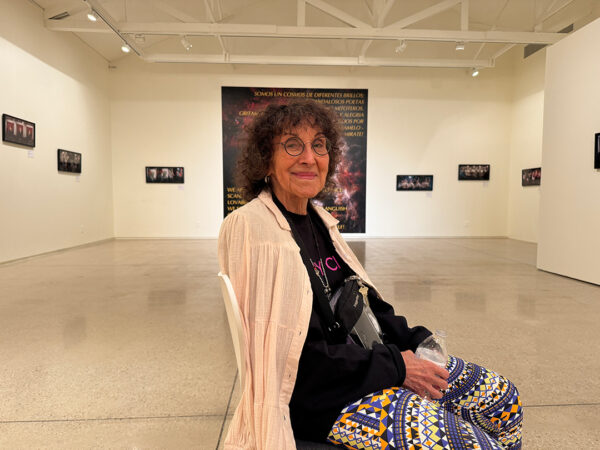
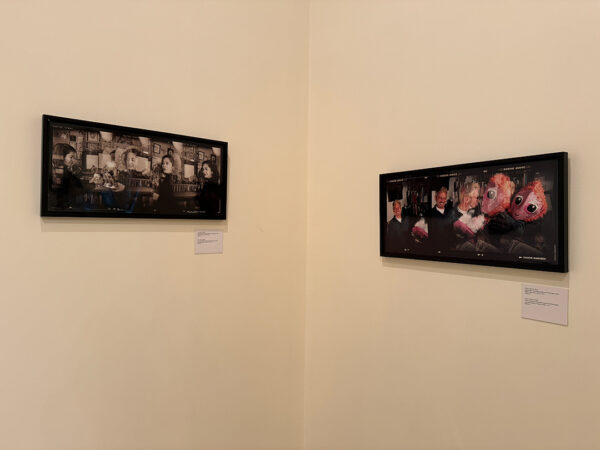
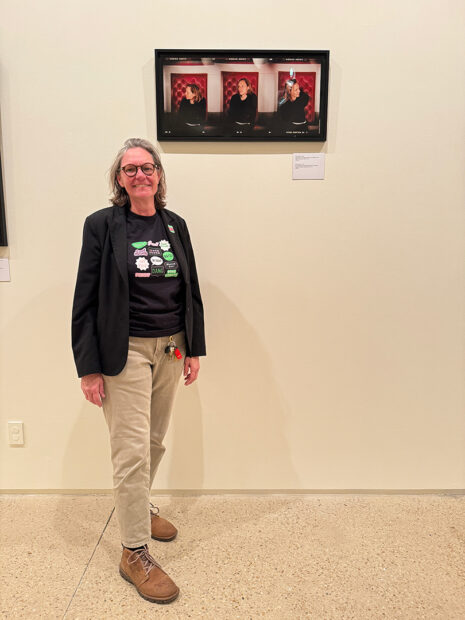
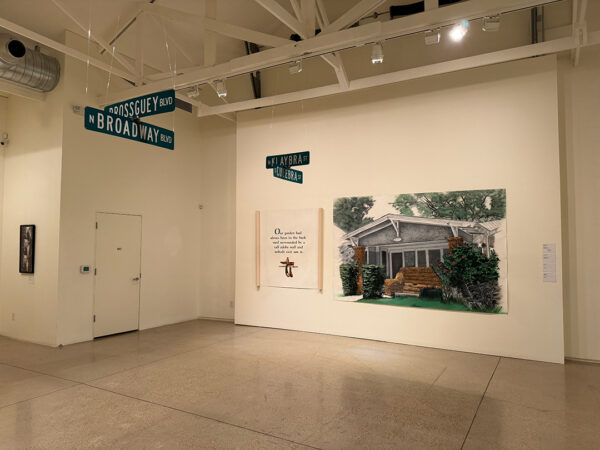
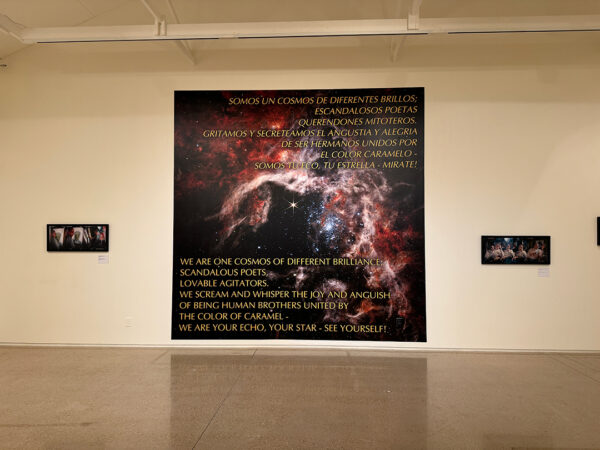
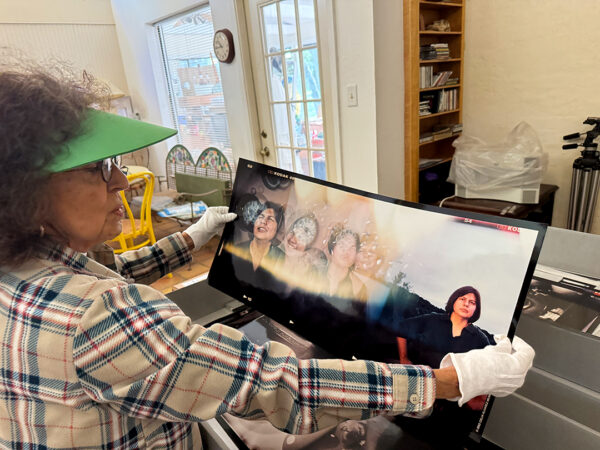

2 comments
Fabulous
Excellent article on one our most distinguished, talented, accomplished Texas Artist from El Chuco town. This article exemplifies the exceptional Artist that we have in Texas that should be acknowledged not just in Texas but the rest on the country. Thank you Jessica Fuentes!